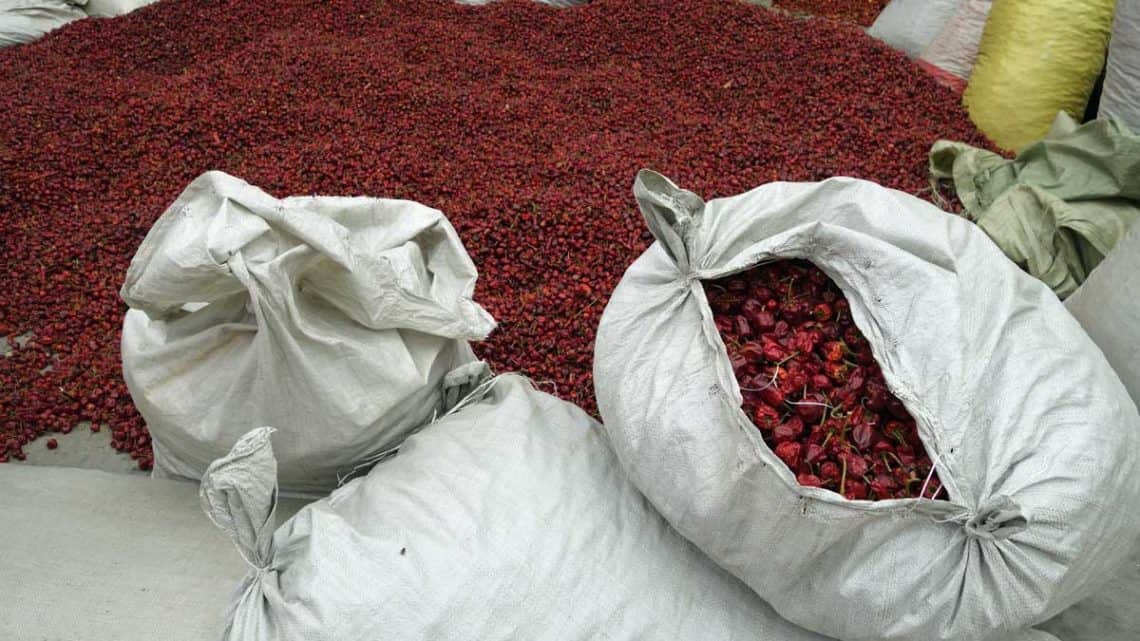Everything seems big in China, but it may still come as a surprise that China is one of the world’s largest producers and consumers of chilli.
Lots of the best chilli are grown in Guizhou, and a lot of that chilli goes through the “Chilli City” in Xiazi, a part of Zunyi.
Xiazi? Zunyi? Even Guizhou? Chances are, you’ve never heard of any of those places. When I say that “a lot of chilli” is traded there, though, I mean a fair amount of the chilli traded in the whole world!
10% of World Trade in Chilli?
2.7 million tons of fresh chilli enter the market in Zunyi’s chilli city, according to numbers they’ve published. Going by FAO production statistics for fresh chilli, that amounts to nearly 8% of the world production.
The amount of dried chilli traded here is said to be 400,000 tons – and that’s 10% of what the FAO says that the world production of dried chilli is!
Looking around in the place, it is a peculiar feeling.
The smell of chilli hangs in the air.
Technology and Big Data
The warehouses for cold storage make it easy to believe that the tonnage traded here should be immense.

The technology involved in it all doesn’t end at cooling. Far from it.
Big data-approaches are starting to be used, to track price developments for the different types of chilli over time and across different marketplaces, to create more stable and preferably higher value.
On this side of things, the presentation and promotion is getting more and more professional; of course, the people involved are professionals as well.

Traders and Middlemen
Seeing the piles of dried chilli that traders collect together from different growers, it looks like a fair amount, but not all that much.
And here, the people involved are better-educated and certainly better at dealing as middlemen, between major buyers from companies and farmers.

Chilli Cutters
Then there are the chilli cutters who work to separate out the spoiled chilli, snip the stems off those types of chilli which are used with the green cap of the pedicel, but not the stem, still on.
All that is done in manual labor, just crouching there.
Here, it becomes eminently visible what people involved in the bureaucracy and promotion of agricultural development often talk about, that the chilli trade is also a part of poverty alleviation and rural development programs.
The “Poor” Chile Pepper
A long-standing link in the human relationship with the chilli continues to be at work here: The chilli seems to have spread so widely so fast, and to have made itself so popular around the world – if hidden away from much attention and high esteem – by the ease with which it could be grown.
Places which could not produce anything much of high value, where it was not just a cliché that it was difficult to just eke out a living, were the same places that chilli grew well. And staple foods in such places were simple starchy fare without much taste, thus much-improved with just the addition of a little bit of chilli.
(In fact, chilli may well have improved both the taste and the nutritional quality of diets, with the chilli adding vitamins C and A, which diets mainly consisting of e.g. rice tend to lack.)
Zunyi Yangrou Fen
Zunyi delivers a delicious hint of these relationships, in the shape of the noodle soup with goat meat, Zunyi yangrou fen, it is known for.

Noodles, a simple way of making cereals useable and delicious; goat meat, from the one kind of “cattle” that can still be raised where conditions are the hardest; as soup, which gives great taste from few ingredients and thus helps stretch their usefulness the widest – and then, of course, spiced and improved with chilli.
Of course, workers of the chilli city can eat right there.

Spicy Value-Add
Now, the chilli is not just the primary resource traded in such places.
Increasingly, there are moves to capture more value from it by also producing spicy sauces and the like.
Zunyi, for example, has its own brand of La-San-Niang (“Three Spicy Girls,” if you will).
And although farther away, one cannot mention chilli in Guizhou without mentioning the province’s – if not the Chinese chilli trade’s – champion company, Laoganma.
And so, from a look at piles of chilli in a remote marketplace in China, we end up at trading connections around the world, with a dip even into traditional, more or less local, (crisp) chilli oils which you may well have in your own kitchen!




Leave a Reply
You must be logged in to post a comment.